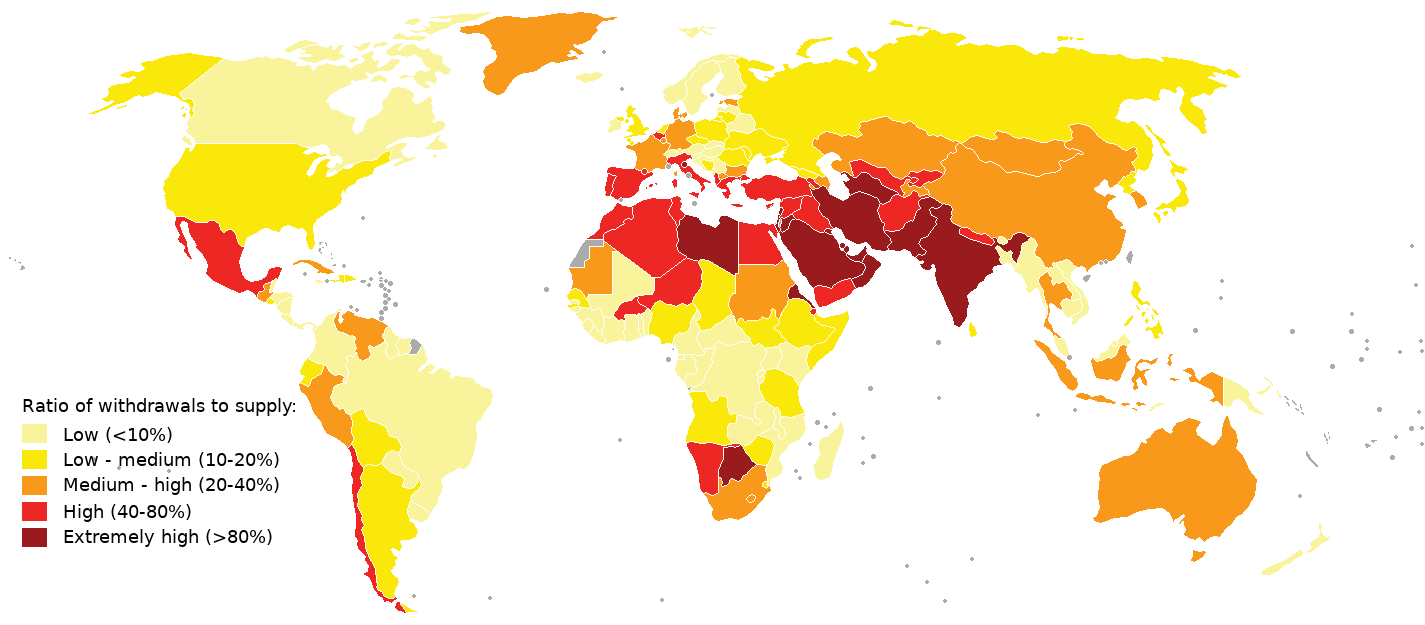
Water scarcity
Water scarcity (closely related to water stress or water crisis) is the lack of fresh water resources to meet the standard water demand. There are two type of water scarcity namely physical and economic water scarcity.[2]: 560 Physical water scarcity is where there is not enough water to meet all demands, including that needed for ecosystems to function. Arid areas for example Central Asia, West Asia, and North Africa often experience physical water scarcity.[3] Economic water scarcity on the other hand, is the result of lack of investment in infrastructure or technology to draw water from rivers, aquifers, or other water sources. It also results from weak human capacity to meet water demand.[2]: 560 Much of Sub-Saharan Africa experiences economic water scarcity.[4]: 11
There is enough freshwater available globally and averaged over the year to meet demand. As such, water scarcity is caused by a mismatch between when and where people need water, and when and where it is available.[5] The main drivers of the increase in global water demand are the increasing world population, rise in living conditions, changing diets (to more animal products),[6] and expansion of irrigated agriculture.[7][8] Climate change (including droughts or floods), deforestation, water pollution and wasteful use of water can also cause insufficient water supply.[9] Scarcity varies over time as a result of natural variability in hydrology. These variations in scarcity may also be a function of prevailing economic policy and planning approaches.
Water scarcity assessments need to incorporate information on green water (soil moisture), water quality, environmental flow requirements, globalization, and virtual water trade.[6] There is a need for collaboration between hydrological, water quality, aquatic ecosystem science and social science communities in water scarcity assessment.[6] "Water stress" has been used as parameter to measure water scarcity, for example in the context of Sustainable Development Goal 6.[10] Half a billion people live in areas with severe water scarcity throughout the year,[5][6] and around four billion people face severe water scarcity at least one month per year.[5][11] Half of the world's largest cities experience water scarcity.[11] There are 2.3 billion people who reside in nations with water scarcities, which means that each individual receives less than 1700 m3 of water annually. However, 380 billion m3 of municipal wastewater are produced globally each year.[12][13][14]
Reducing water scarcity requires supply and demand side management, cooperation between countries and water conservation (including prevention of water pollution). It also requires expanding sources of usable water (through wastewater reuse or desalination) and virtual water trade.
Scale[edit]
Current estimates[edit]
Water scarcity was listed in 2019 by the World Economic Forum as one of the largest global risks in terms of potential impact over the next decade.[43] It is manifested by partial or no satisfaction of expressed demand, economic competition for water quantity or quality, disputes between users, irreversible depletion of groundwater, and negative impacts on the environment.
About half of the world's population currently experience severe water scarcity for at least some part of the year.[44] Half a billion people in the world face severe water scarcity all year round.[5] Half of the world's largest cities experience water scarcity.[11] Almost two billion people do not currently have access to clean drinking water.
[45][46] A study in 2016 calculated that globally, the population under water scarcity increased from 0.24 billion (14% of global population) in the 1900s to 3.8 billion (58%) in the 2000s.[1] This study analyzed water scarcity using the fundamental concepts of shortage (impacts due to low availability per capita) and stress (impacts due to high consumption relative to availability).